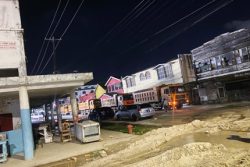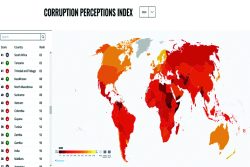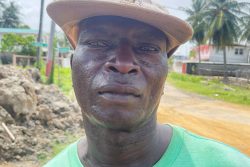Dear Editor,
On Saturday, March 23, an article was carried in the Guyana Times headlined ‘Toshaos Council accuses Govt of elections meddling’. It raised a number of issues of concern to the National Toshaos Council (NTC).
Firstly, it is claimed that there are communities whose council members are summoned to meetings without the Toshaos’ knowledge and this undermines the legitimacy and credibility of the Toshaos and village councils.
Secondly, they claim that the government is seeking to politicize the office of the Toshaos and that this is a threat to the indigenous people.
Thirdly, they claim that the government is showing disregard for the budgetary needs of the NTC by allocating only $16M to the council for the year. It is claimed that the 16M sum will be spent on the four quarterly meetings of council executives and as such nothing will be left for outreaches to promote good governance and to educate the indigenous people.
They claimed that they represent the interest of 83,000 Amerindians and received only $16M while two small communities comprising of 200 and 3000 residents received $20M and $30M respectively.
Fourthly, they claimed that there is no movement to have a revision of the Amerindian Act.
Fifthly, they complained about the government not sticking to the 2013 agreement with the UNDP to use US$10.7M from Norway to issue titles to 16 communities and a commitment to not grant new leases in those areas that were proposed to be titled or extended.
The NTC noted that if the above stated issues are not addressed, then they will forever be begging for their rights to be respected. If the government cannot commit to implementing change, they will be asking all the Indigenous people to gather in Georgetown for a mass protest.
With regard to the first issue, it demonstrates disunity in the council when a councillor runs off to visit the government officials without him or herself informing the Toshao or the entire council. The government officials are therefore not the main culprits in this issue but rather the councillors themselves in the first instance, and then Toshaos, who are displaying poor management skills. When such a situation arises, and the matter is brought to the rest of the community, the credibility of the Toshaos and council cannot be diminished unless they are acting contrary to the wishes of the community, and would therefore be happy to have someone take up their cause with the government officials.
On the second issue of politicising the office of the Toshaos, it appears that the persons in the NTC do not know their history. The position of the Toshaos has always been politicised. The Dutch kept the tribal leader close to them to facilitate trade with the rest of the tribes. The English gave gifts of food and implements to the tribal leaders and members of the tribes in an effort to keep them close to the missions for easy mobilization in case the British needed their assistance in controlling the African slaves. The PNC government politicised the village captains to gain dominance in the Amerindian communities during their quest to make the party paramount. The PPP/C continued the same policy of control and dominance by, among other things, instituting the annual presidential grant. The current government will be doing the same. How the NTC handles it will determine if they intend to make a break with the past.
On the third issue of the budgetary allocation for the NTC, what comes to mind is why is this group of community leaders who do not want government meddling in their affairs, who do not want the office of the Toshao to be politicised, are so dependent on an annual government subvention? If they had asked Martin Carter our national poet, he surely would have referred them to the lines from his poem: “a mouth is always muzzled by the food it eats to live”. Unless they raise their own income from the grass roots communities, they will always be dependent on the government. Furthermore, what tangible benefits are derived in the communities from the spending of $16M on four quarterly meetings of the executive committee? My guess is that the hotel and restaurant owners would have been the greater beneficiaries.
On the fourth issue of the revision of the Amerindian Act, have they discussed the sections that need to be revised with the communities or are they hoping that the government will initiate a revision in isolation? They need to start a national debate amongst Amerindians and possibly concerned non-Amerindians about the proposed changes needed. Then lobby for the change.
The fifth issue is somewhat more complex. It concerns land titling. Ever since Independence in 1966, the issue of land titling in Amerindian communities has been ongoing. After 52 years, the titling of land to 83000 Amerindians is still incomplete. Based on the NTC statement, 67 communities are waiting for this exercise to be completed. I believe that this whole land titling has now become counterproductive to the development of the Amerindian people of this country. What happens when the Amerindian population increases? Would they just keep asking for extensions or new titles? Such an exercise could lead to ethnic conflicts given the population size/acreage ratio. Secondly, how beneficial have the titled lands been to the Amerindians who live there? Can they take that title to the bank and acquire a loan to build a home or start business ventures? I honestly do not believe that this is happening or could happen. So the Amerindians on those titled lands are still outside the mainstream of the Guyanese economy. Some advocates of land titling would claim that those lands are ancestral lands and that they are spiritual and religious attachments. However, they are forgetting that at the time of arrival of the Europeans the tribes in Guyana were migratory; slowly moving from south-west to north-east and to date there is no Amerindian religion in Guyana other that what the Europeans handed down.
It is time that the NTC encouraged Amerindians to buy property like other Guyanese citizens, and stop being huddled on reservations to perpetuate a lifestyle of hunting and fishing and to go dancing in tibisiri skirts for government officials and other dignitaries. The time for that is over. Every other race in Guyana and other nations have passed through that phase of human development. How many of them still dance with a lap cloth. NTC wake up!
Yours faithfully,
Victor Kersting Sr






